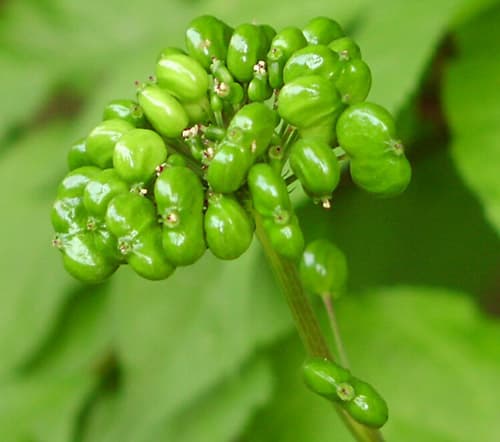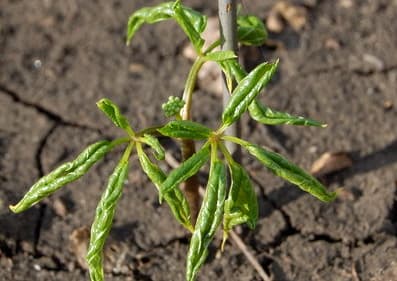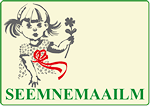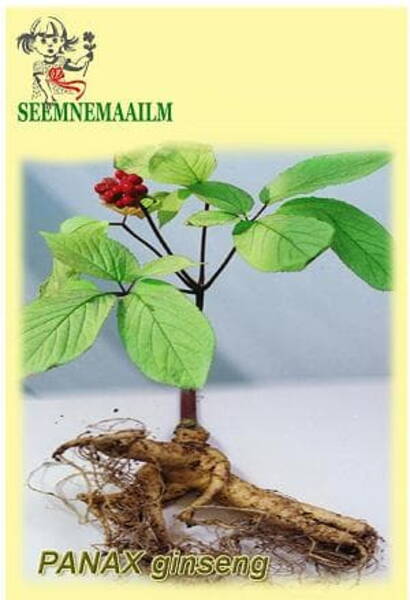Medicinal perennial from the Araliaceae family.
Flowering plant height: 40 cm.
Flower colour: white-green.
Natural flowering period: June - August.
Winter hardiness zones: Z5 - Z8.
Very beneficial plant, roots very valuable for medical purposes.
To grow ginseng, you need loose, fertile soil that is free of diseases and pests. Usually, ginseng growers take the top layer of soil from the forest with loose forest litter as the basis of the soil mixture, add as much fallen leaves of trees as possible, dust from rotten stumps or old (lying for more than a year) sawdust, a little completely rotted mullein, river sand and ash.
If you keep such a mixture for about a year and shovel it three or four times during the summer season, periodically watering it with water, you will get an excellent soil mixture that will be easy to loosen in the garden bed even by hand. In the language of professional agronomists, the soil requirements can be formulated as follows: pH = 5.5 ... 6.5, humus content 6 ... 10%, nitrogen, phosphorus and potassium 5 ... 8, 15 ... 25 and 25 ... 35 mg of active substance per 100 grams of soil, respectively. The soil should be sufficiently air- and moisture-permeable.
The bed for ginseng should be located in a place that is not flooded even in heavy rains or melt water. It is advisable to lay drainage of sand, crushed stone or slag at the bottom of the bed in a layer of 15 ... 25 cm, the borders of the bed should be turned down to a depth of 20 ... 30 cm to prevent the penetration of mouse-like rodents. The long side of the bed is oriented from east to west - this makes it easier to organize optimal lighting. The most convenient width of the bed is 1...1.2 m. After the soil mixture is ready, before pouring it into the bed, it should be sifted through a sieve with a cell of 10...15 mm and remove the larvae of May beetles and other pests. The thickness of the soil mixture layer on the bed should be at least 15...20 cm when sowing seeds and 25...30 cm when transplanting young roots to a permanent place. Before planting seedlings or sowing seeds, the soil mixture should lie on the bed for about 2...4 weeks, and it is advisable to pre-water it with a 0.1...0.3% solution of potassium permanganate at a solution rate of 1...2 watering cans per square meter.
Lighting plays a very important role during the growth of seedlings and adult ginseng plants. Necessary and sufficient lighting is approximately equal to 20...30% of the passing sunlight. Most often, this is achieved by shading with slatted shields installed at a height of 1...1.5 m above the surface of the beds. The width of the shading slats is 5...10 cm, the distance between the slats is 2...3 cm. Similar shields are installed on the southern, eastern and western sides of the bed. On the northern side, it is enough to install a net that protects the bed from the penetration of domestic animals, which love to lie in the partial shade on fresh soil. The upper shields above the bed should have a slope from north to south, a polyethylene film is fixed on top of the shields, or the slats on top should be paved to drain rainwater.
Sowing seeds and planting ginseng seedlings is carried out either in the fall, in October, or in the spring, in the second ten days of April. Spring planting is carried out in a very short time, since immediately after the soil thaws, the seeds and seedlings of ginseng quickly begin to grow and fragile sprouts can be easily damaged. Sowing is usually carried out with stratified seeds at a depth of 3...5 cm according to the scheme of 2...5 cm in a row and 10...15 cm between rows. If you sow freshly collected seeds, the shoots will appear only after 20...22 months, since "natural" stratification occurs during the year, during which the embryo develops very slowly, the seed cracks slightly and is ready to germinate after the next winter. Seed germination after natural stratification can exceed 90%.
"Accelerated" stratification of freshly collected seeds at home is often used, for which the seeds are mixed with clean coarse-grained slightly damp sand immediately after collection and kept for about 4 months at a temperature of 15...25 degrees, without over-moistening and without allowing them to dry out. After the end of the four-month "warm" period of stratification, the seeds are transferred to conditions with a temperature of 0...+3 degrees and kept for about 3.5...4 months, that is, until spring sowing at the end of April. Seed germination after accelerated stratification can reach 70% in the first spring, some seeds remain "dormant" and will sprout the following spring. However, seedlings obtained from seeds after almost two years of natural stratification are less susceptible to diseases than after accelerated stratification.

Ginseng shoots usually appear in spring on May 1-10 in the form of a "hook" or "loop" and bloom and grow in height for about 1.5-2 months. During the shoots, it is advisable to thicken the shading over the beds by throwing spruce branches, boards, etc. over the shields. By the end of the first year of vegetation, the height of the above-ground part of the plant reaches 5-7 cm, and the root weighs almost 1 gram and reaches a length of 7-15 cm. Seedlings are grown in one place for up to 1-2-3 years, after which they are transplanted to a permanent place. The composition of the soil mixture and the arrangement of the beds for seedlings and adult plants are approximately the same. The best time to plant seedlings is in October, when the thin, web-like seasonal roots die off and the transplant is almost painless. The seedlings are planted at intervals of 20...30 cm almost horizontally, placing the apical bud at a depth of 5...7 cm. It is believed that the horizontal method of planting seedlings was invented by the Koreans and they kept it a secret from potential competitors for a long time. By the way, in Korea there is currently a ban on the export of ginseng seeds; they prefer to sell dried roots to other countries. During the growing season, it is advisable to carry out two or three preventive sprayings of the ginseng plantation with a 0.01...0.03% solution of potassium permanganate in May-June, followed by spraying the leaves with clean water. In mid-April or at the end of October, it is useful to spray the bed and the structures of shading structures with 1...2% Bordeaux mixture in small quantities. Watering the plantation is carried out approximately once a week in dry and hot weather and somewhat less often in cool weather, the water consumption is about 7...10 liters per square meter. If there is no film over the shading shields, then watering is carried out mainly during a long absence of rain. From about the age of four, ginseng plants on the plantation begin to bear full-fledged seeds. In June, the plants bloom, outwardly very nondescript flowers emit a very thin, weak aroma, reminiscent of the best French perfumes, flowering continues for about two weeks, moving from the periphery of the flower basket to its center. During this period, it is advisable to exclude water from getting on the flowers during watering or rain, so that pollination and fruit setting are more complete. Ginseng fruits with one or two seeds inside each "berry" ripen in the first half of August, at this time the ginseng plants have the most attractive appearance - flower stalks with a cap of bright red berries rise above the green foliage. During this period, ginseng seekers in the coastal taiga have the best chance of seeing extremely rare red ginseng caps among the greenery of the taiga.
In autumn, at the end of October, the ginseng plantation is prepared for wintering, for which the plants are cut with pruning shears near the soil level, after the first frosts the beds are sprinkled with a layer of 5...10 cm of dry sawdust or fallen leaves and the upper shading shields are removed. It is believed that ginseng reaches commercial quality on the plantation at the age of five years, when the weight of the roots exceeds 40...50 grams, and the content of extractive substances exceeds at least 20%. In Canada, ginseng is sold starting from the age of four.
For Estonia, it is considered optimal to grow ginseng on the plantation up to 6...7 years of age, after which the weight and quality of the roots increases, but the likelihood of their loss also increases.

Chinese ginseng, Asiatic ginseng, ginseng root, Korean ginseng. Bot. syn.: Aralia ginseng Mey., Panax schinseng Nees., Aralia quinquefolia var. ginseng (C.A. Mey.), Panax pseudoginseng Wall., Panax quinquefolius var. ginseng (C.A.Mey.) Regel et Maack.












